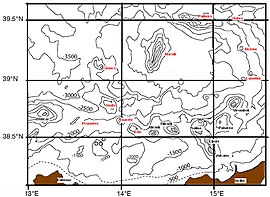Marsili
| Marsili | |
|---|---|
 Aeolian arc, including coastline and depth contour lines for every 500 meters. | |
| Summit depth | −450 m (−1,476 ft) |
| Height | 3,000 m (9,800 ft) |
| Location | |
| Location | Tyrrhenian Sea |
| Coordinates | 39°15′00″N 14°23′40″E / 39.25000°N 14.39444°E |
| Country | Italy |
| Geology | |
| Type | Submarine volcano |
| Volcanic arc/chain | Aeolian Arc |
| Last eruption | 1050 BC ± 200 years[1] |
Marsili is a large undersea volcano in the Tyrrhenian Sea, about 175 kilometers (109 mi) south of Naples. The seamount is about 3,000 m (9,800 feet) tall; its peak and crater are about 450 m below the sea surface. Though it has not erupted in recorded history, volcanologists believe that Marsili is a relatively fragile-walled structure, made of low-density and unstable rocks,[2] fed by the underlying shallow magma chamber. Volcanologists with the Italian National Institute of Geophysics and Volcanology (INGV) announced on March 29, 2010, that Marsili could erupt at any time, and might experience a catastrophic collapse that would suddenly release vast amounts of magma in an undersea eruption and landslide that could trigger destructive tsunamis on the Italian coast and nearby Mediterranean coastlines.[3]
Geomorphology
[edit]Marsili belongs to the Aeolian Islands volcanic arc. It is one of the largest volcanoes in Europe, with a length of 70 kilometres (43 mi) and a width of 30 kilometres (19 mi),[4] larger than Mount Etna. It was discovered during the 1920s and named after Italian geologist Luigi Ferdinando Marsili. Extensive studies have been carried on only since 2005 as the Italian National Research Council started a vulcanology research program on the site.
The volcano rises from a plateau of thin oceanic (or pseudo-oceanic) crust with a thickness of only 10 km, which forms its own sea basin. The basin crust is made of tholeiitic basalt which is most typical of inflated basins at the back of oceanic volcanic arcs. The Marsili basin appears to have formed very recently (2 million years) as a consequence of the growth of the volcanic arc, and Marsili could be the result of the thermal inflation of the thin crust at the center of the basin. The start of the volcano activity could date back as recently as 200,000 years ago. Evidence of lava flows on the mountain flanks was found. Evidence of catastrophic collapses of previous other undersea volcanoes in the same area was also found.
Potential risks
[edit]Marsili is an active volcano,[4][5] with numerous satellite volcanic systems. The magma of Marsili is similar in composition to other volcanoes in the Aeolian Arc. The magma of Marsili came from the Ionian subduction of the seafloor of the Tethys Ocean.[6] The volcanic activity started less than 200,000 years ago. Traces of volcanic collapse have been found on the sides of other submarine volcanoes, which may have resulted from tsunamis along the Tyrrhenian coast of southern Italy.
Marsili is on a list of the most dangerous submarine volcanoes of the Tyrrhenian Sea, along with Magnaghi, Vavilov, and Palinuro.[7] As with Vavilov, Marsili is at risk of a major collapse from a single event.[8] In addition, hydrogeological deep-water surveys show that there is geothermal activity on Marsili.[9]
Marsili has been studied since 2005 as a strategic project of the Italian National Research Council[10] by means of a sonar system and integrated monitoring networks for ocean observations. In February 2010, the research vessel Urania began a study on the submerged volcano. Considerable instability has been detected. A significantly large region of the Marsili summit is also made up of low-density rocks, strongly weakened by hydrothermal alteration phenomena; which could cause a large collapse event.[8][11]
-
Geological, geotectonic, structural section of the Central Mediterranean Subduction System
See also
[edit]References
[edit]- ^ "IUCN Atlas of the Mediterranean Seamounts. Seamounts and Seamount-Like Structures of the Tyrrhenian Sea" (PDF). Retrieved 31 July 2019.
- ^ Caratori Tontini F., Cocchi L., Muccini F., Carmisciano C., Marani M., Bonatti E., Ligi M., and Boschi E., Potential-field modelling of collapse-prone submarine volcanoes in the Southern Tyrrhenian Sea (Italy), Geophysical Research Letter 37 (2010), L03305, doi:10.1029/2009GL041757.
- ^ "Undersea volcano threatens southern Italy: report". AFP. March 29, 2010. Retrieved August 16, 2014.
- ^ a b Caprara, Giovanni (2010-03-29). "Torna a far paura il vulcano sommerso nel Tirreno". Corriere della Sera (in Italian). Retrieved 2011-03-18.
- ^ "CNR: Marsili, un vulcano ancora attivo". Le Scienze. Roma: Gruppo Editoriale L'Espresso. 2014-01-14. Retrieved 2014-01-17.
- ^ Pepe, Fabrizio; Sulli, Attilio; Bertotti, Giovanni; Cella, Federico (June 2010). "Architecture and Neogene to recent evolution of the Western Calabrian continental margin: An upper plate perspective to the Ionian subduction system, Central Mediterranean". Tectonics. 29 (3). Bibcode:2010Tecto..29.3007P. doi:10.1029/2009TC002599. S2CID 129595554.
- ^ Ortolani, Franco. "Le coste italiane a rischio tsunami e la legge che verrà... il giorno dopo". meteoweb.it. Retrieved 2011-03-18.
- ^ a b Caratori Tontini, F; Cocchi, L; Muccini, F; Carmisciano, C; Marani, M; Bonatti, E; Ligi, M; Boschi, E (2010). "Potential‐field modeling of collapse‐prone submarine volcanoesin the southern Tyrrhenian Sea (Italy)". Geophysical Research Letters. 37 (3): n/a. Bibcode:2010GeoRL..37.3305C. doi:10.1029/2009GL041757. hdl:11567/1047746. S2CID 134799142.
- ^ Lupton, John; de Ronde, Cornel; Sprovieri, Mario; Baker, Edward T.; et al. (2011). "Active hydrothermal discharge on the submarine Aeolian Arc". J. Geophys. Res. 116 (B2): B02102. Bibcode:2011JGRB..116.2102L. doi:10.1029/2010JB007738.
- ^ "Osservatori sottomarini multidisciplinari" (in Italian). INGV.
- ^ Tropea, Serena. "Vulcani. D'Anna (Ingv): "Il Marsili erutterà? Non c'è nessuna evidenza scientifica"" (in Italian). Dire.it. Archived from the original on 2013-05-03. Retrieved 2013-03-07.
The idea of a tsunami is not farfetched, but the main source will not be an eruption, but maybe a landslide.
External links
[edit]- "Marsili". Global Volcanism Program. Smithsonian Institution. Retrieved 2021-06-25.


